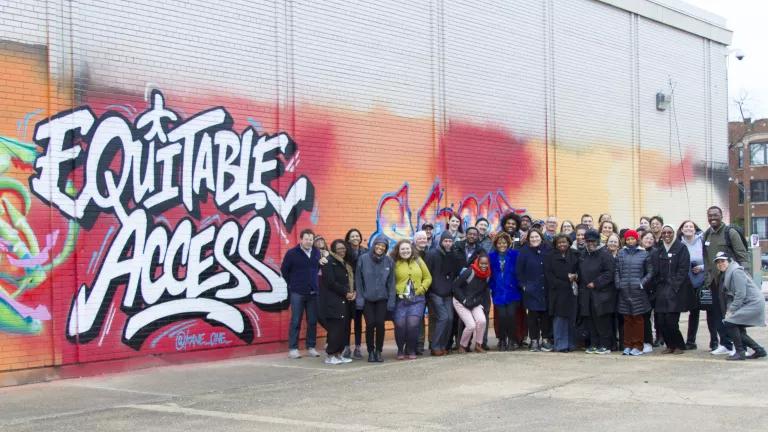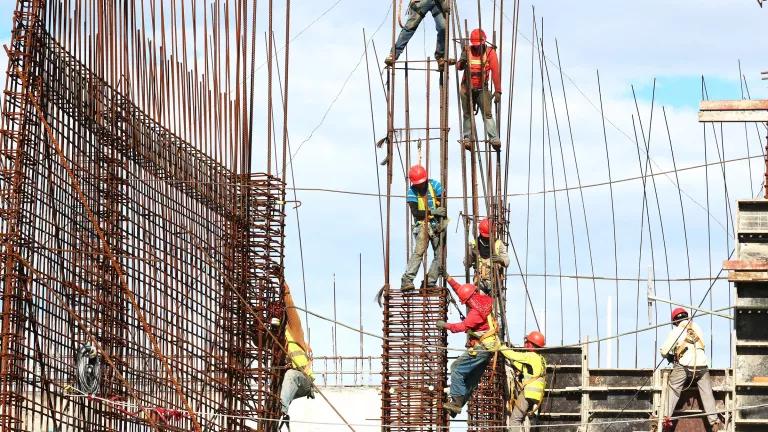Putting Climate into the Infrastructure Law
Transportation investments from the bipartisan infrastructure bill could be either a boon for sustainable mobility choices, or a boon for harmful carbon emissions.

Transportation investments from the bipartisan infrastructure bill could be either a boon for progress driven by sustainable mobility choices, or a boon for harmful carbon emissions paved by many miles of new highways, researchers at Georgetown University said in a new report.
The key now is how this will be implemented by the Department of Transportation and state and regional agencies. In order to ensure that investments address the climate crisis before us, they all must develop new guidance and criteria for spending taxpayer dollars, amend and enhance state and metropolitan area long-range 20-year plans and short-range 4-year improvement programs, and carefully select, develop, and deliver many, many infrastructure projects.
The work of these agencies in 2022 will be especially pivotal to determining the trajectory of investments in this massive new bill, because the bipartisan infrastructure legislation includes the largest-ever five-year surface transportation reauthorization. In fact, surface transportation spending accounts for about half the total package of $1.2 trillion.
So how do those dollars now translate to projects in communities across America? Federal and state government agencies, with involvement from local jurisdictions mostly through the 408 metropolitan planning organizations (MPOs), are working to implement the bill through long-range plans spanning 20 years, short-term improvement programs spanning 4 years, and development of individual projects.
This is a historic bill. It takes the spending in the previous transportation authorization and adds $284 billion. President Biden and Transportation Secretary Buttigieg tout its historic investments in public transit and passenger rail, as well as historic spending on bicycle and pedestrian projects.
Its single biggest investment category, however, is roads and bridges. Jeff Davis of the Eno Center for Transportation broke this down the minute the bill was firmed up back in August:

We’ve known for decades that road capacity expansions generate additional vehicle traffic, as my colleague Carter Rubin has written about recently. That leaves us with a fundamental question: What will this new law do to greenhouse gas emissions from transportation? A group of us analyzed the emission-reducing (or -increasing) potential of different investment categories about a decade ago in the Moving Cooler report, and it would be useful to bracket what’s probable to help inform government agency implementation of this massive injection of investments.
Thankfully, the Georgetown Climate Center did the heavy analytical lifting and unveiled the results this week. Specifically, they categorized investments across the country based on their likely effects on travel demand and vehicle emissions, then aggregated them based on investments in the new bill. They built two scenarios—high- and low-emissions. The former assumes that federal, local and especially state agencies invest more in new roadbuilding and less in cleaner alternatives including buses, trains, and electric vehicles. It also assumes that fewer repairs are made on our existing 4-million-mile road system. The result is that the bill exacerbates our climate crisis, driving up pollution from transportation, already the biggest culprit in our emissions challenge.
The good news is that we can instead choose a low-emissions future. And it comes down to how states and regions choose to spend this new transportation funding from Congress.

To explain why this scenario is quite possible, it’s worth giving a brief history of the federal transportation program. Three decades ago we completed a national project that spanned the previous 30 years: We built a world-class system of interstate highways, launched by the Eisenhower-era National Interstate and Defense Highways Act (1956 Act, P.L. 84-627). For more on this era when we laid down ribbons of asphalt criss-crossing the country, check out great books such as Divided Highways and The Big Roads.
That era ended when Congress and President GHW Bush’s Administration created a new law, the Intermodal Surface Transportation Efficiency Act of 1991 (ISTEA, P.L. 102-240). This law restructured federal policy in several ways, for example by providing new, dedicated funding to clean the air (a complement to new mandates in the 1990 Clean Air Act Amendments, P.L. 101-549) with the new Congestion Mitigation and Air Quality Improvement program (CMAQ) included among the highway accounts. It elevated the role of MPOs in planning and programming transportation dollars. ISTEA also made flexibility a core characteristic of highway accounts as exemplified by the Surface Transportation Program (now called the Surface Transportation Block Grant program or STBG). Since then, federal highway money has become ever more flexible with MPOs and states able to spend it on low-carbon alternatives including public transportation, bicycle and pedestrian facilities, as well as electric vehicle charging infrastructure.
Yet state transportation agencies have underutilized this increasing flexibility. And as Ian Duncan of the Washington Post described in June, even within the road investment category there’s imbalance in state spending. 4 million miles of roads criss-cross the country and all-too-many of them are in desperate need of repair (former Transportation Secretary Ray LaHood underscored this by referring to America as “one big pothole”). Yet states have chosen to defer maintenance such that we now have a backlog that’s more than two-thirds the size of this new massive surface transportation law at a whopping $435 billion according to the Federal Highway Administration.
The new Georgetown analysis shows that if states tackle that backlog of repairs to assets already built, and use the flexibility Congress has delivered yet again in this massive new law, they will be heroes in confronting our climate challenge. This would also deliver bigger economic benefits compared to new roadbuilding, as Smart Growth America found to be the case in the wake of the last outsized investment in transportation in the American Reinvestment and Recovery Act of 2009 (ARRA, P.L. 111-5). Thankfully some state transportation agencies are ahead of the curve in diversifying their portfolio of investments beyond new roadbuilding.
And to be clear, this IS about transportation plan, program, and project diversification and not a simple binary choice. Georgetown’s low-emissions scenario has roadbuilding in it. It just mixes in more clean transportation investments that help reduce pollution.
That is our preferred future, and now we need to get to work on delivering it during what President Biden has rightly dubbed the infrastructure decade ahead.


